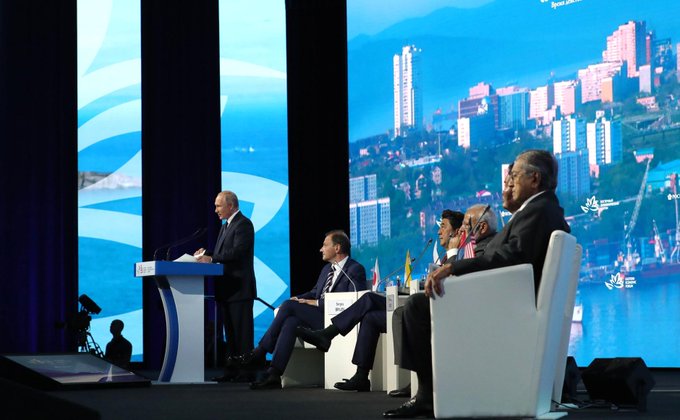Target Russia. Target China. Target Iran
Not a day goes by without US Think Tankland doing what it does best;
pushing all sorts of scenarios for cold – and hot – war with Russia, plus
myriad confrontations with China and Iran.
That fits into the Pentagon’s Top Five existential threats to the US,
where Russia and China sit at the very top and Iran is in fourth place – all
ahead of «terrorism» of the phony Daesh «Caliphate» variety.
Here I have come up with some concise
realpolitik facts to counterpunch the hysteria – stressing how the Russian
hypersonic missile advantage renders useless the whole construct of NATO’s
paranoid rhetoric and bluster.
The US Aegis defense system has been transferred from ships to land. The
Patriot missile defense system is worthless. Aegis is about 30% better than the
THAAD system; it may be more effective but their range is also limited.
Aegis is not a threat at all to Russia – for now. Yet as the system is
upgraded – and that may take years – it could cause Russia some serious
concern, as Exceptionalistan is increasingly pushing them eastward, so near to
Russia’s borders.
Anyway, Russia is still light-years ahead in hypersonic missiles. The
Pentagon knows that against the S-500 system, the F-22, the awesomely expensive
F-35 and the B-2 stealth airplanes – stars of a trillion-dollar fighter program
– are totally obsolete.
So it’s back to the same old meme: «Russian aggression», without which
the Pentagon cannot possibly fight for its divine right to be showered with unlimited
funds.
Washington had 20,000 planners at work before WWII was ended, focused on
the reconstruction of Germany. Washington had only six after the destruction of
Iraq in 2003’s Shock and Awe.
That was no incompetence; it was «Plan A» from the get-go. The former
USSR was deemed a mighty threat at the end of WWII – so Germany had to be
rebuilt. Iraq was a war of choice to grab oil fields – mixed with the
implementation of hardcore disaster capitalism. No one in Washington ever cared
or even wanted to rebuild it.
«Russian aggression» does not apply to Iraq; it’s all about Eastern
Europe. Russian Foreign Minister Sergey Lavrov anyway
has made it clear that
the deployment of the Aegis will be counterpunched in style – as even US
corporate media starts to
admit that the
Russian economy is healing from the effects of the oil price war.
Take a look at my liquid asssets
Here my purpose was to show that
China is not a House of Cards. Whatever the real Chinese debt to GDP ratio –
figures vary from as low as 23% to 220% – that is nothing for an economy the
size of the Chinese, especially because it is entirely internally controlled.
China keeps over $3 trillion in US dollars and other Western
currencies in reserves while it gradually delinks its economy from the
real House of Cards: the US dollar economy.
So under these circumstances what does foreign debt mean? Not much.
China could – although they don't do it yet – produce more yuan and buy back
their debt, as much as the US with quantitative easing (QE) and the European
Central Bank (ECB) as it asks certain 'favorite countries' (strong NATO
supporters) to produce more than their share of euros.
And yet Beijing doesn't really need to do this. China, Russia, the
Shanghai Cooperation Organization (SCO) and what's left of the BRICS (Brazil is
on hold until at least 2018) are slowly but surely forging their own internal
currency and currency transfer system (in China and Russia it works already
internally) to sideline SWIFT and the Bank of International Settlements (BIS).
When they are ready to roll it out for the rest of the world to join
them, then US dollar-based foreign debt will be meaningless.
US Think Tankland, as usual, remains
clueless. As one of
my Chinese sources explains,«whenever a Western big mouth mentions China's
debt ‘problem’ they quote a figure that seems to come out of thin air, and it
includes all debts, central, provincial, city government levels, estimated all
corporate debts, loans from banks outside China. Meanwhile, they compare this
total number in China with those of Western countries and Japan's central
government debt alone».
The source adds, «China is operating with a balance sheet of the
equivalent to $60 trillion. Loans from external sources is in the $11 trillion
range while cash and equivalent is in the $3.6-4 trillion range. All this cash
– or very liquid asset – is the biggest discretionary force in the hands
of China's leaders while nothing worth mentioning is in the hands of any other
Western government».
Not to mention that globally, Beijing is betting on what the World
Economic Forum calls the Fourth Industrial Revolution. China is already the
central hub for global production, supply, logistics and value chain. Which
leads us to One Belt, One Road (OBOR); all roads lead to the Chinese-driven New
Silk Roads, which will connect, deeper and deeper, China’s economy and
infrastructure all across Eurasia. OBOR will simultaneously expand China’s
global power while geopolitically counterpunching the so far ineffective «pivot
to Asia» – Pentagon provocations in the South China Sea included – and
improving China’s energy security.
Sanctions, like diamonds, are forever
Another major Exceptionalistan fictional narrative is that the US is «worried» about the inability of
European banks to do business in Iran. That’s nonsense; in fact, it’s the US
Treasury Department that is scaring the hell out of any European bank who dares
to do business with Tehran.
India and Iran have struck a $500 million landmark deal to develop the Iranian port of
Chabahar – a key node in what could be dubbed the New India-Iran Silk Road,
connecting India to Central Asia via Iran and Afghanistan.
Immediately afterwards the US State Department has the gall to announce
that the deal will be «examined» – as the proverbial Israeli-firster US
senators question whether the deal violates those lingering sanctions against
Iran that refuse to go away. This happens in parallel to a mounting official
narrative of «unrest» contaminating former Soviet republics in Central Asia –
especially Kazakhstan and Tajikistan. CIA-paid hacks should know those sources
of unrest well – as the CIA itself is fomenting it.
India doing business with Iran is «suspicious». On the other hand, India
is more than allowed to formalize a historic military cooperation deal with the
US hazily dubbed the «Logistics Support Agreement» (LSA) – according to which the two
militaries may use each other’s land, air and naval bases for resupplies,
repairs and vaguely-defined «operations».
So it’s all hands on deck all over Exceptionalistan to counter Russia,
China and prevent any real normalization with Iran. These localized offensives
– practical and rhetorical – on all fronts always mean one thing, and one thing
only; splitting and fracturing, by all means necessary, the OBOR Eurasian
integration. Bets can be made that Moscow, Beijing and Tehran simply won’t be
fooled.
/https://www.niagarafallsreview.ca/content/dam/thestar/news/canada/2021/09/25/huawei-executive-meng-wanzhou-receives-warm-welcome-upon-return-to-china/_1_meng_wanzhou_2.jpg)







![]()

















No comments:
Post a Comment
Note: Only a member of this blog may post a comment.